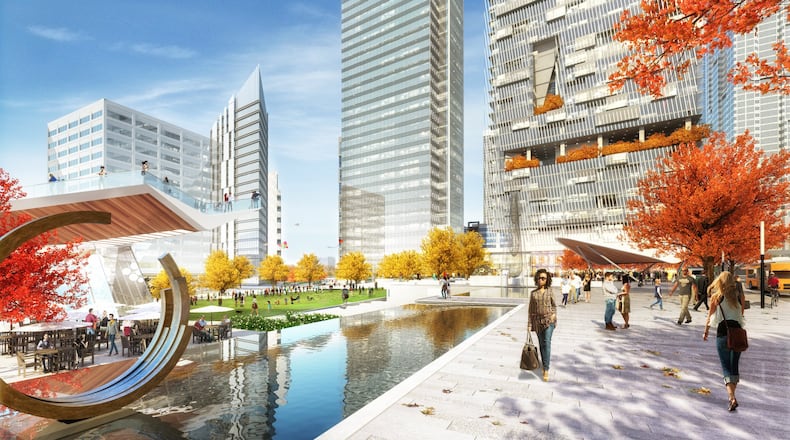Construction of Atlanta’s interstates decades ago severed vital arteries that tied together neighborhoods as well as the city’s central business district.
But an ambitious concept unveiled this week by business coalition Central Atlanta Progress would build a deck over the Downtown Connector featuring parks and reconnecting a disjointed street grid.
The as-yet-unfunded proposal, fittingly called “The Stitch,” would re-establish links between Midtown and downtown over about 14 acres, opening up underused land for private-sector development.
The deck would essentially cap three-quarters of a mile of I-75/I-85 from Spring Street to the area near Georgia Power’s headquarters.
The plan is modeled after other “deck parks” such as the 5.2-acre Klyde Warren Park in Dallas, but this concept is much larger and would present greater opportunities for high-density development. The Stitch also would come with a much larger price tag: estimated at more than $300 million for the parks and streets alone, or three times the Dallas project.
The Stitch concept is just that for now, and detailed engineering and financing plans have not yet been drafted. A.J. Robinson, chief executive of CAP, said feasibility studies — including figuring out how to pay for such a thing — would be the next step.
Such planning might cost about $1 million, he said, and CAP would like seek aid from other groups to fund further study.
Robinson said a portion of the infrastructure cost could be financed through leasing air rights above the Connector, federal grants and donations from nonprofits and other groups could be a part of the mix. He said it’s plausible a significant portion of the project could be done within five years.
The project would require the OK of a number of groups, including local, state and federal governments
“I think this project is ambitious and difficult, but I think it is highly achievable,” Robinson said. “It makes a lot economic sense and it will pay for itself.”
The report estimates the project could stimulate $1.1 billion in redevelopment and property value growth, and significantly boost tax revenue.
Robinson said the project could be built in a way that minimizes the impact on commuters on one of the South’s busiest highways.
The $100,000 design study was drafted by the Atlanta office of international engineering firm Jacobs and paid for by the Atlanta Downtown Improvement District, which managed by CAP.
The proposal ranks among the more ambitious plans to reinvigorate the urban core, including a long hoped-for but not realized multi-modal transit hub in Downtown’s Gulch.
Robinson ranks the city-shaping potential of such a project with the Beltline, which has stimulated a surge of development east of downtown, and Centennial Olympic Park.
“This is much more of a city and a regional project I believe because it involves so many moving parts,” he said.
Talk of a deck park over the Connector has percolated at CAP since at least 2003, Robinson said, and the state also has considered similar proposals near the state Capitol.
Boston’s Big Dig buried freeways and replaced them with green space and pedestrian areas, rejuvenating the city’s downtown.
Atlanta Mayor Kasim Reed called the concept “terrific.”
“We’re really excited about it and we’re in the stages of trying to figure out how to make it so, because we have a unique moment in the life of the city and the region because we finally have revenue streams to figure out how to pay for all of these things.”
Dan Owens, CEO of Emory University Hospital Midtown and a CAP board member, said much of the proposed green space would wrap around the hospital complex and new streets could relieve some bottlenecks.
“Finding the money is going to be critical to this,” he said.
Separately, the Buckhead Community Improvement District has studied a similar idea with Jacobs. The design concept near Lenox Square would create a park stretching from Atlanta Financial Center on Peachtree Road to the Lenox Road-Ga. 400 interchange. It would essentially cover Ga. 400 and the Buckhead MARTA transit station, creating an at-grade and walkable connection to apartment towers and office buildings now cut off by the highway.
About the Author
Keep Reading
The Latest
Featured




